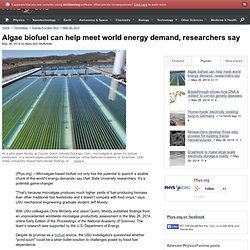

Oil plunges as Opec tests the mettle of US shale industry. Algae biofuel can help meet world energy demand, researchers say. (Phys.org) —Microalgae-based biofuel not only has the potential to quench a sizable chunk of the world's energy demands, say Utah State University researchers.

It's a potential game-changer. "That's because microalgae produces much higher yields of fuel-producing biomass than other traditional fuel feedstocks and it doesn't compete with food crops," says USU mechanical engineering graduate student Jeff Moody. With USU colleagues Chris McGinty and Jason Quinn, Moody published findings from an unprecedented worldwide microalgae productivity assessment in the May 26, 2014, online Early Edition of the Proceedings of the National Academy of Sciences. The team's research was supported by the U.S.
Department of Energy. Desert plants fed with saltwater produce amazing new biofuel for Boeing and Etihad. In 2012, the world’s airlines transported three billion people, emitting 689 million tonnes of CO2 into the atmosphere.

To mitigate the aviation industry’s future environmental impact, Boeing, Etihad Airways and the Masdar Institute of Technology are working on a groundbreaking new jet fuel made from desert plants fed with saltwater. While the aviation industry only contributed two per cent of the world’s total CO2 emissions, its environmental impact is significant enough, and fossil fuels sufficiently infinite, that major airlines such as Boeing and Etihad are concerned to find new sources of clean energy.
On January 18 the group announced that they have discovered that halophytes (plants that can grow in saline conditions) fed with nutrient rich wastewater produce an efficient biofuel. The leftover water from this can then be used to feed mangrove forests, where it is purified before returning to the Persian Gulf. Cold-tolerant oil-producing sugarcane could be one sweet source of biofuel. Scientists are working on a biofuel-producing strain of sugarcane (Photo: Shutterstock) Sugarcane grows like crazy, so if it could be used as a source of biofuel, well ... not only might it produce higher yields than other crops, but it could conceivably do so using less land.

With that in mind, scientists from the University of Illinois are creating a strain of the plant that produces more oil, gets more energy from the sun, and can be grown in colder climates. Led by plant biologist Prof. Stephen P. Long, the researchers have introduced genes to sugarcane plants, that boost the oil production in their stems by 1.5 percent. Additionally, his team genetically engineered sugarcane plants to be 30 percent more photosynthetically efficient, meaning that they get 30 percent more growth energy from a given amount of sunlight than regular sugarcane. QUANT e-Sportlimousine with nanoFLOWCELL® drive. Vaclav Smil’s graph of the year: The natural-gas boom. Time has its "Person of the Year.

" Amazon has its books of the year. World's largest ship floated for the first time. The 488-m-long hull of the Prelude FLNG is floated for the first time Image Gallery (6 images) A hull longer than the Empire State Building is tall has been floated out of dry dock in Geoje, South Korea.

Measuring 488 m (1,601 ft) long and 74 m (243 ft) wide, the hull belongs to Shell's Prelude floating liquefied natural gas (FLNG) facility, which upon completion will be the largest floating facility ever built. View all Intended to allow production of natural gas, the processing of it into liquefied natural gas (LNG) and finally the transfer directly to transport ships, all while at sea, the Prelude will weigh more than 600,000 tonnes (661,400 tons) fully loaded and is expected to produce around 3.6 million tonnes (3.9 million tons) of LNG per year. Peak Oil as seen through the eyes of Arab oil producers. Summary: One of the world’s great energy experts reports on the view from a energy conference in Qatar.

Oil is the fountain of their prosperity, and they well understand how brief the Age of Oil will be. Neftegax.Ru, 16 March 2010 Reflections by Robert Hirsch on the Conference “Peak Oil: Challenges and Opportunities for the GCC Countries”. Held at Doha, Qatar on 2-4 April 2013. Can your car run on seaweed? This startup thinks so. A group of scientists has gone offshore in an effort to bypass the food-versus-fuel debate.

Startup Bio Architecture Lab today published a paper in Science it claims will turn seaweed into a viable feedstock for fuel and other chemicals. Making fuel and chemicals from crops such as corn and sugar cane requires significant quantities of land and fresh water, creating competition for resources with agriculture. Macroalgae such as seaweed, by contrast, grow in salt water and are relatively productive energy sources because they are 60 percent carbohydrates and don't contain lignin, which binds up useful molecules in many earthbound plants.
Fuel from market waste - Research News - February 2012 - Topic 3. Drivers who fill up with natural gas instead of gasoline or diesel spend less on fuel and are more environmentally friendly.

Natural gas is kinder on the wallet, and the exhaust emissions it produces contain less carbon dioxide and almost no soot particles. As a result, more and more motorists are converting their gasoline engines to run on natural gas. But just like oil, natural gas is also a fossil fuel, and reserves are limited. Researchers at the Fraunhofer Institute for Interfacial Engineering and Biotechnology IGB in Stuttgart have now developed an alternative: They have found a way to obtain this fuel not from the Earth’s precious reserves of raw materials, but from fruit and vegetable waste generated by wholesale markets, university cafeterias and canteens.